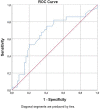Investigation of perfusion defects by Q-SPECT/CT in patients with mild-to-moderate course of COVID-19 and low clinical probability for pulmonary embolism
- PMID: 34173212
- PMCID: PMC8231747
- DOI: 10.1007/s12149-021-01647-y
Investigation of perfusion defects by Q-SPECT/CT in patients with mild-to-moderate course of COVID-19 and low clinical probability for pulmonary embolism
Erratum in
-
Correction to: Investigation of perfusion defects by Q‑SPECT/CT in patients with mild‑to‑moderate course of COVID‑19 and low clinical probability for pulmonary embolism.Ann Nucl Med. 2021 Oct;35(10):1126. doi: 10.1007/s12149-021-01660-1. Ann Nucl Med. 2021. PMID: 34319548 Free PMC article. No abstract available.
Abstract
Objective: Pulmonary embolism is a severe source of mortality and morbidity in patients with severe and critical coronavirus disease 2019. It is not yet clear whether the tendency to thrombosis is increased in the mild-to-moderate course of COVID-19. Our research aims to show the clinical benefit of Q-SPECT/CT in diagnosing PD in outpatients treated with mild-to-moderate course of COVID-19 and to determine the frequency of perfusion defects in these patients having relatively lower risk.
Methods: All patients who underwent Q-SPECT/CT with suspicion of embolism were examined retrospectively. Only patients with low clinical probability and mild-to-moderate course of COVID-19 for PE were included in the study. The patients were evaluated comparatively as those with and without perfusion defects. Patients were divided into laboratory suspicion, clinical suspicion, or clinical and laboratory suspicion.
Results: In outpatients with mild-to-moderate COVID-19 with low clinical probability for PE, PD without CT abnormality was detected with a rate of 36.6% with Q-SPECT/CT performed for complaints of high D-dimer and/or dyspnea. None of the patients had PD at more proximal level than the segment level. PD with no concomitant CT abnormality was observed with a rate of 56.5% in patients with both clinical and laboratory suspicion. For D-dimer = 0.5 mg/dL cut-off sensitivity is 85%, for D-dimer = 1.5 mg/dL cut-off specificity 81%.
Conclusion: Thrombosis tendency is also present in outpatients with mild-to-moderate COVID-19, and these patients should also be offered anticoagulant prophylaxis during the COVID-19 period.
Keywords: COVID-19; Pandemic; Perfusion defects; Pulmonary embolism; Q-SPECT/CT.
© 2021. The Japanese Society of Nuclear Medicine.
Figures




Comment in
-
The potential role of SPECT/CT in the clinical management of COVID-19 lung cancer patients undergoing radiotherapy.Ann Nucl Med. 2021 Oct;35(10):1174-1176. doi: 10.1007/s12149-021-01662-z. Epub 2021 Jul 28. Ann Nucl Med. 2021. PMID: 34322785 Free PMC article. No abstract available.
Similar articles
-
Clinical utility of perfusion (Q)-single-photon emission computed tomography (SPECT)/CT for diagnosing pulmonary embolus (PE) in COVID-19 patients with a moderate to high pre-test probability of PE.Eur J Nucl Med Mol Imaging. 2021 Mar;48(3):794-799. doi: 10.1007/s00259-020-05043-y. Epub 2020 Sep 22. Eur J Nucl Med Mol Imaging. 2021. PMID: 32959115 Free PMC article. Review.
-
Ventilation/perfusion SPECT/CT findings in different lung lesions associated with COVID-19: a case series.Eur J Nucl Med Mol Imaging. 2020 Sep;47(10):2453-2460. doi: 10.1007/s00259-020-04920-w. Epub 2020 Jun 18. Eur J Nucl Med Mol Imaging. 2020. PMID: 32556400 Free PMC article.
-
The Utility of Hybrid SPECT/CT Lung Perfusion Scintigraphy in Pulmonary Embolism Diagnosis.Respiration. 2015;90(5):393-401. doi: 10.1159/000439543. Epub 2015 Sep 30. Respiration. 2015. PMID: 26418469
-
Investigation of the ongoing pulmonary defects with perfusion-single photon emission computed tomography/computed tomography in patients under anticoagulant therapy for coronavirus disease 2019-induced pulmonary embolism.Nucl Med Commun. 2022 Sep 1;43(9):978-986. doi: 10.1097/MNM.0000000000001595. Epub 2022 Jun 23. Nucl Med Commun. 2022. PMID: 35947122
-
A critical appraisal of non-invasive diagnosis and exclusion of deep vein thrombosis and pulmonary embolism in outpatients with suspected deep vein thrombosis or pulmonary embolism: how many tests do we need?Int Angiol. 2005 Mar;24(1):27-39. Int Angiol. 2005. PMID: 15876996 Review.
Cited by
-
The Clinical Utility of Molecular Imaging in COVID-19: An Update.Semin Nucl Med. 2023 Jan;53(1):98-106. doi: 10.1053/j.semnuclmed.2022.09.002. Epub 2022 Sep 22. Semin Nucl Med. 2023. PMID: 36243572 Free PMC article. Review.
-
Cardiovascular manifestations identified by multi-modality imaging in patients with long COVID.Front Cardiovasc Med. 2022 Sep 23;9:968584. doi: 10.3389/fcvm.2022.968584. eCollection 2022. Front Cardiovasc Med. 2022. PMID: 36211553 Free PMC article.
-
The diagnostic accuracy of perfusion-only scan in the diagnosis of pulmonary embolism in the era of COVID-19: A single-center study of 434 patients.Ann Thorac Med. 2023 Oct-Dec;18(4):199-205. doi: 10.4103/atm.atm_42_23. Epub 2023 May 16. Ann Thorac Med. 2023. PMID: 38058788 Free PMC article.
-
Effect of Anticoagulants in Pulmonary Thromboembolism in Post-COVID-19 Patients.Cureus. 2023 May 23;15(5):e39382. doi: 10.7759/cureus.39382. eCollection 2023 May. Cureus. 2023. PMID: 37362508 Free PMC article.
-
Treatment and long term follow-up results in patients with pulmonary vascular thrombosis related to COVID-19.Medicine (Baltimore). 2024 Nov 1;103(44):e40319. doi: 10.1097/MD.0000000000040319. Medicine (Baltimore). 2024. PMID: 39495981 Free PMC article.
References
MeSH terms
Substances
LinkOut - more resources
Full Text Sources
Medical

